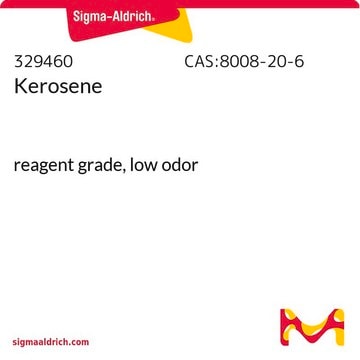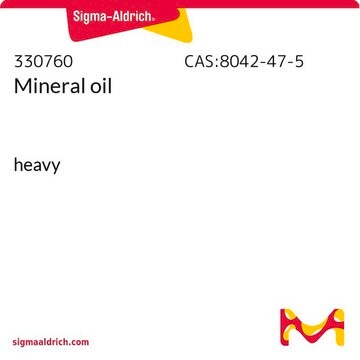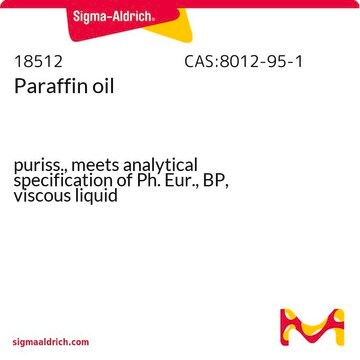54362
ICP Lösungsmittel
for inorganic trace analysis, ≥99.9995% (metals basis)
Synonym(e):
Hydrotreated light distillate (petroleum)
About This Item
Empfohlene Produkte
Qualität
for inorganic trace analysis
Qualitätsniveau
Assay
≥99.9995% (metals basis)
Methode(n)
AAS: suitable
ICP: suitable
bp
200-250 °C (lit.)
mp (Schmelzpunkt)
-58 °C (lit.)
Dichte
0.810-0.838 g/mL at 20 °C
Anionenspuren
phosphate (PO43-): ≤1 mg/kg
sulfate (SO42-): ≤5 mg/kg
Kationenspuren
Ag: ≤1 μg/kg
Al: ≤1 μg/kg
As: ≤1 μg/kg
Au: ≤1 μg/kg
Ba: ≤0.5 μg/kg
Be: ≤0.5 μg/kg
Bi: ≤0.5 μg/kg
Ca: ≤20 μg/kg
Cd: ≤0.5 μg/kg
Ce: ≤0.5 μg/kg
Co: ≤0.5 μg/kg
Cr: ≤1 μg/kg
Cu: ≤1 μg/kg
Fe: ≤5 μg/kg
Ga: ≤0.5 μg/kg
Ge: ≤0.5 μg/kg
In: ≤0.5 μg/kg
Ir: ≤0.5 μg/kg
K: ≤10 μg/kg
Li: ≤0.5 μg/kg
Mg: ≤1 μg/kg
Mn: ≤0.5 μg/kg
Mo: ≤0.5 μg/kg
Na: ≤10 μg/kg
Ni: ≤1 μg/kg
Pb: ≤0.5 μg/kg
Pd: ≤1 μg/kg
Pt: ≤0.5 μg/kg
Rb: ≤0.5 μg/kg
Rh: ≤0.5 μg/kg
Ru: ≤0.5 μg/kg
Sb: ≤0.5 μg/kg
Sn: ≤0.5 μg/kg
Sr: ≤0.5 μg/kg
Ti: ≤1 μg/kg
Tl: ≤0.5 μg/kg
U: ≤0.5 μg/kg
V: ≤0.5 μg/kg
Zn: ≤50 μg/kg
Zr: ≤0.5 μg/kg
Anwendung
Signalwort
Danger
H-Sätze
Gefahreneinstufungen
Asp. Tox. 1
Lagerklassenschlüssel
10 - Combustible liquids
WGK
WGK 1
Flammpunkt (°F)
158.0 °F
Flammpunkt (°C)
70 °C
Choose from one of the most recent versions:
Besitzen Sie dieses Produkt bereits?
In der Dokumentenbibliothek finden Sie die Dokumentation zu den Produkten, die Sie kürzlich erworben haben.
Kunden haben sich ebenfalls angesehen
Unser Team von Wissenschaftlern verfügt über Erfahrung in allen Forschungsbereichen einschließlich Life Science, Materialwissenschaften, chemischer Synthese, Chromatographie, Analytik und vielen mehr..
Setzen Sie sich mit dem technischen Dienst in Verbindung.









